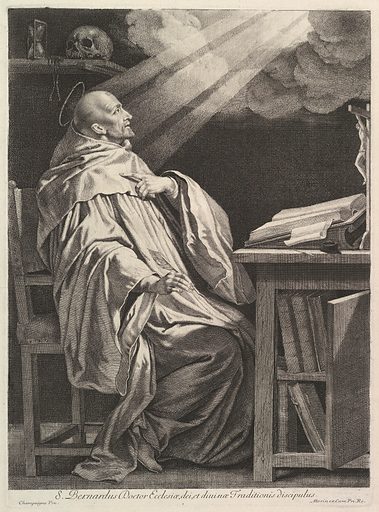The Man of the Twelfth Century

Bernard of Clairvaux was an influential character within the Church of the twelfth century and is considered by many to be one of the giants of the Christian faith. A theologian, biblical scholar, articulate preacher, prolific rhetorician, hymn writer, defender of the faith, reformer, anti-schismatic, and supporter of the Second Crusade, St. Bernard was widely known throughout Christendom for his wisdom and counsel on all issues surrounding the early Church.
In 1111, Bernard left his home near Dijon, Burgundy, to join the monastery in Cîteaux. Coming from a deeply religious family, Bernard had five brothers, two uncles, and nearly 30 other friends who joined him in the monastery. His parents were some of the highest nobility of Burgundy, and it was said that he developed an interest in literature and rhetoric at a young age.
Three years after joining the monastery of Cîteaux, he was sent with a group of twelve monks to found Clairvaux Abbey, an expansion of the Cistercian Order. Over time, Bernard’s reputation as a strong religious mentor and church leader traveled far and wide across Europe. He was often called away from his monastery in order to settle disputes, including deep-seeded issues in Rome. He often urged the Christians there to do all that they could to keep the Church as one whole and to avoid furthering the growing separations between different factions. While traveling he wrote hundreds of letters to his companions and colleagues all across Europe, leaving behind traces of his thoughts regarding all the important religious and secular issues of his day.
The pope eventually called Bernard to become part of the Second Crusade and gave him a full military team to accompany him. However, the project was not as successful as anticipated and ended as an utter disaster. It was said that this failure weighed heavily on Bernard and that he spent the last years of his life contemplating the effects of the crusade. He died at age sixty-three in August of 1153.

A Brief History
Celebrated widely throughout the Church in the years after his death, Bernard was quickly canonized and later called a doctor of the Church. His fame increased immensely during the fifteenth and sixteenth centuries due to a wider distribution of his letters and books. He is often listed together with Augustine, Jerome, Ambrose, and Gregory as one of the most outstanding teachers of the Church.
St. Bernard also had great influence on the Reformers, including Martin Luther who was known to quote the twelfth-century abbot frequently in his work. Part of the reason why is that Bernard was a prominent articulator of sola fide.
Further, Bernard’s articulate confession of the faith and writings for the Church are still revered by many Lutherans today. For example, the texts of “O Sacred Head, Now Wounded” (LSB 449–450) and “O Jesus King, Most Wonderful” (LSB 544), both found in our Lutheran Service Book, are attributed to him.

Collect
O God, Who didst give Blessed Bernard to Thy people as a minister of eternal salvation: grant, we beseech Thee, that we, who have had him for our teacher on earth, may with him enjoy Thine eternal glories; through Jesus Christ our Lord, who liveth and reigneth with Thee and the Holy Ghost: ever one God, world without end. Amen.
Epistle
Gospel
Resources
Issues, Etc. interview with the Rev. Dr. Cameron MacKenzie on Theologian and Hymnwriter, Bernard of Clairvaux
Issues, Etc. interview with the Rev. Dr. David Coles on Bernard of Clairvaux
Propers found in Daily Divine Service Book: A Lutheran Daily Missal, edited by the Rev. Heath Curtis
References:
1. Weedon, William. Celebrating the Saints. Concordia Publishing House. 2016.
2. Theo M.M.A.C. Bell. “Luther’s Reception of Bernard of Clairvaux.” Concordia Theological Quarterly 59, no. 4 (1995): 245-278.
Images:
1. Saint Bernard de Clairvaux, Jean Morin, France, ca. 1605-1650.
2. Life of Saint Bernard of Clairvaux: Saint Bernard mediates a dispute between Bishop Stephan von Bar and Duke Matthew von Lothringen in Metz, made for the glazed cloister at Altenberg, near Cologne, Germany, ca. 1535.
3. Apparition of the Virgin to St. Bernard, Filippino Lippi, Italy, ca. 1485-1487.
Some links might be affiliate links which means we may receive a small commission at no extra cost to you. As an Amazon Associate we earn from qualifying purchases.




[…] musical morality play; and extensive correspondence with those outside the convent, including with St. Bernard of Clairvaux. It was also in this period that she began to travel more widely across Germany, evangelizing large […]